11.1: Early Indus Valley Civilizations
- Page ID
- 53018
Indus Valley Civilization
The Indus Valley Civilization was an urban civilization from 3300–1300 BCE that covered most of present-day Pakistan and northwest India.
Learning Objectives
Draw a timeline of the Early, Mature, and Late Harappan Phases of the Indus Civilization, noting the cultural accomplishments of each
Key Takeaways
Key Points
- The Indus Valley civilization is often separated into three phases: Early Harappan Phase (3300 BCE–2600 BCE), Mature Harappan Phase (2600 BCE–1900 BCE), and Late Harappan Phase (1900 BCE–1300 BCE).
- Cities of the ancient Indus Valley had multistory brick buildings, employed an advanced sanitation system, and used a unified system of weight and measurement.
- Most inhabitants of Indus Valley cities were artisans, and many artifacts —such as sculptures , seals, pottery, gold, jewelry, elaborate beadwork, and anatomically detailed figurines —have been excavated.
- There is evidence of an extensive trade network used to import raw materials, such as lapis lazuli and steatite , to the Indus Valley from distant regions.
- Between 400 and 600 distinct Indus symbols indicate a language found on ceramics , seals, and tablets, though the language remains entirely unknown to this day.
Key Terms
- lapis lazuli: A relatively rare, intensely blue, semi-precious stone.
- steatite: A stone that contains a large amount of the mineral talc and is easily malleable; also known as soapstone.
- Bronze Age: A period in a civilization’s development when the most advanced metalworking has developed the techniques of smelting copper from natural outcroppings and allows it to be cast in bronze.
Overview: The Indus Valley Civilization
The Indus Valley Civilization was a Bronze Age urban civilization that existed from 3300–1300 BCE and covered most of present-day Pakistan and northwest India. Situated around the Indus River and the Ghaggar-Hakra River, the Indus Valley civilization is also known as the Harappan civilization, named after Harappa, the first city to be excavated in the 1920s.
Inhabitants of the ancient Indus Valley developed new and notable techniques in handicraft, metallurgy , trade and transportation, systems of measurement, and urban planning.
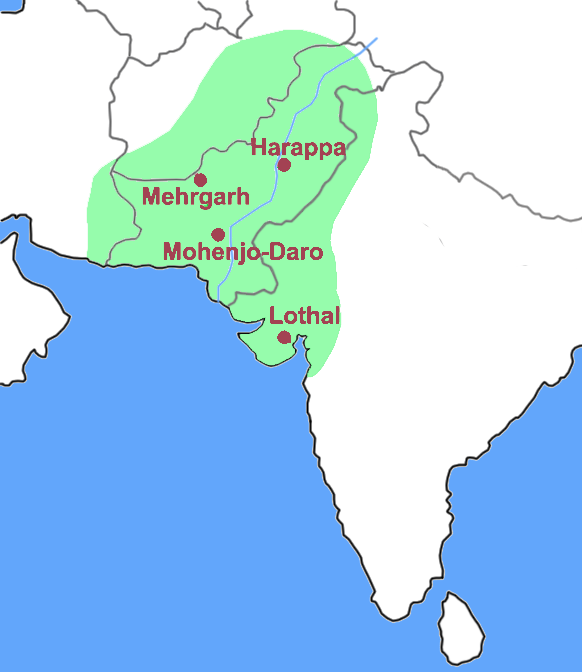
Indus Valley civilization map: This map illustrates the extent of the Indus Valley Civilization, imposed over the borders of modern-day Pakistan and northwest India.
The civilization is often separated into three phases:
- Early Harappan Phase (3300 BCE–2600 BCE).
- Mature Harappan Phase (2600 BCE–1900 BCE).
- Late Harappan Phase (1900 BCE–1300 BCE).
The Mature Harappan phase was the cultural high point, a time by which communities had grown into well-functioning, enormous urban centers. Many more artistic artifacts—such as ceramics, sculptures, seals, and jewelry—have been excavated from this time than from some civilizations that began centuries after its decline.
Numerous architectural remains have been found as well, including multistory buildings, baths, and dockyards. To date, over 1,052 cities and settlements have been found in the general area of the rivers and their tributaries, with the major ones being Harappa, Mohenjo-Daro, Dholavira, Rupar, Lothal, and Kalibangan.
Indus Valley Cities
The cities of the ancient Indus Valley consisted of highly functional, multistory buildings and structures constructed with uniform, kiln-burnt bricks. There is evidence of urban planning due to the uniformity of size and the style of the brickwork, as well as the organization of streets and neighborhoods into grid patterns, much like many current cities.
The first-known sanitation system, whereby waste-water was directed into covered drains that lined major streets and where clean water was obtained from wells in a designated room in the home, was employed in the ancient Indus Valley. This system of sewage and drainage is quite remarkable and was more advanced than some seen even today.
The Indus Valley Civilization is also known for developing a unified system of weight and measurement, as well as a decimal system and the first known use of negative numbers. In 2001, it was discovered that people from the early Harappan period had knowledge of proto-dentistry with the excavation of the first evidence of drilled human teeth.
Art in the Indus Valley
The Indus Valley period is well documented through the wealth of artifacts that were excavated from its magnificent cities. It is widely believed that most of the inhabitants of Indus Valley cities were tradespeople and artisans. Archaeologists have excavated sculptures, seals, pottery, gold jewelry, elaborate beadwork, and anatomically detailed figurines in terracotta , ceramic, bronze, lead, tin, and steatite from the ancient Indus Valley area.
A number of bronze, gold, stone, and terracotta figures of girls in dance poses reveal the presence of some dance forms from the time, and a harp-like instrument depicted on a seal indicates the use of stringed musical instruments.
Similarities in the iconography and construction of excavated artifacts suggest the considerable mobility and trade networks of the Indus Valley inhabitants. Raw materials found only in distant regions, such as lapis lazuli and steatite, were imported for artistic use. It is believed that the trade networks of the Indus Valley reached as far as Afghanistan, coastal Persia, northern and western India, Mesopotamia , and Egypt.

Dancing Girl of Mohenjo-daro: A small, 4500-year-old bronze statuette of a dancing girl that was excavated in Mohenjo-daro in 1926.
The iconography of the artifacts from the Indus Valley region often depict quite anatomically correct animals and human figures. Similar to other civilizations of the same time period, such as Ancient Egypt and Mesopotamia, there are many depictions of female figures, or possibly fertility goddesses.
One motif shows a horned figure seated in a posture reminiscent of the lotus position and surrounded by animals; this was named Pashaputi (lord of cattle) by excavators. Between 400 and 600 distinct Indus symbols that indicate a language have been found on ceramics, seals, and tablets, though the language remains entirely unknown to this day.
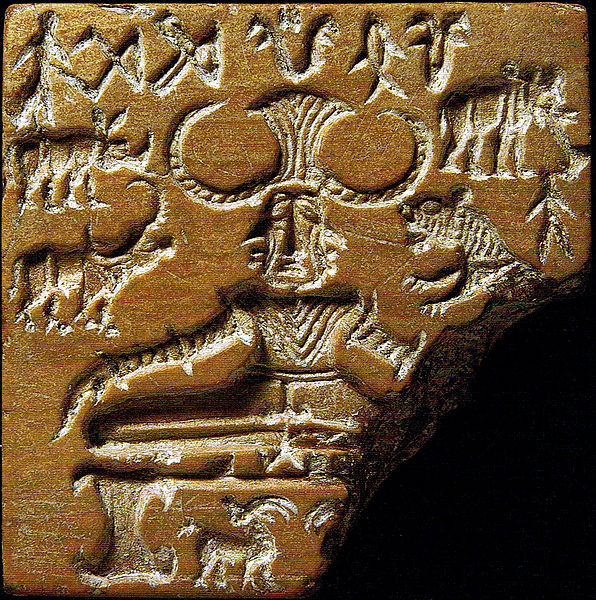
Pashupati: Discovered at Mohenjo-daro, this seal depicts a seated, horned figure surrounded by animals, who is commonly interpreted to be Pashupati, the Lord of Cattle.
Indus Valley Society
Socially, the Indus Civilization appears to have been relatively egalitarian in nature. All homes within its various cities had access to water and drainage facilities and were generally equal in size. The evidence for planned settlements and the uniformity of Harappan artifacts suggests a strong organizational or governing force in the Indus Valley Civilization, though archaeological records provide no immediate answers.
Around 1800 BCE, signs of decline began to emerge in the Indus River Valley. By 1700 BCE, many of the cities had been abandoned. The reason for the decline of the civilization is unknown, but it is theorized to be due to enemy invasion throughout the area, a change in climate to significantly cooler and drier conditions, or the disappearance of the Ghaggar-Hakra River. After the collapse, regional cultures emerged that continued to show the influence of the Indus Valley Civilization to varying degrees.
Vedic and Upanishadic Periods
The Vedic period in India (c. 1700–500 BCE) is marked by the composition of the Vedas, the oldest scriptures of Hinduism.
Learning Objectives
Evaluate the crafts and texts found during the Vedic Period in India
Key Takeaways
Key Points
- The Vedic civilization is thought to have been centered in the northern and northwestern parts of the Indian subcontinent.
- The transmission of stories in the Vedic period was by oral tradition alone, and a literary tradition began only in post-Vedic times.
- Crafts within Vedic culture included chariot-making, cart-making, carpentry, metal-working, tanning, bow-making, sewing, weaving, leather work, pottery, jewelry, dying, and vintnery.
- Pottery in the Vedic period is divided into black- and red-ware culture (BRW, c. 12th to 9th centuries BCE) and painted grey-ware culture (PGW, c. 1200 BCE to 600 BCE).
- The Vedas are a large body of texts that originate in the Vedic period. Composed in Vedic Sanskrit , the texts constitute the oldest layer of Sanskrit literature and are the oldest scriptures of Hinduism . The Upanishads are a collection of philosophical texts that form the theoretical basis for the Hindu religion. All Upanishads are associated with one of the four Vedas—Rigveda, Samaveda, Yajurveda, and Atharvaveda—and have been passed down in oral tradition.
Key Terms
- Sanskrit: A classical language of India (Latin would be its English equivalent), it is a liturgical language of Hinduism, Buddhism, Sikhism, Jainism, and one of the 23 official languages of India.
- Vedic Period: A period in Indian history during which the the oldest scriptures of Hinduism were composed; the time span of the period is uncertain, though is thought to span from 1700 BCE to about 500 BCE.
- Upanishad: An authorless, Hindu, religious and philosophical text considered to be an early source of the religion, it is found mostly as the concluding part of the Brahmanas and in the Aranyakas.
Overview: India’s Vedic Period
The Vedic period (or Vedic age) in India was a period in history during which the Vedas, the oldest scriptures of Hinduism, were composed. The time span of the period is uncertain, though it is thought to span from 1700 BCE to about 500 BCE, with 150 BCE suggested as a terminus ante quem (the latest possible time) for all Vedic Sanskrit literature. The transmission of stories in the Vedic period was by oral tradition alone, and a literary tradition began only in post-Vedic times.
The associated culture, sometimes referred to as the Vedic civilization, was probably centered in the northern and northwestern parts of the Indian subcontinent, but it has now spread and constitutes the basis of contemporary Indian culture. In the 11th century BCE, the Vedic society transitioned from semi-nomadic life to settled agriculture.
This transition led to an increase in trade and increased competition and conflicts over resources, such as land and water. However, after 1000 BCE, the use of iron axes and ploughs enabled the clearing of jungles, and the Vedic kingdoms were able to expand along the Gangetic plains, ushering in the later Vedic age.
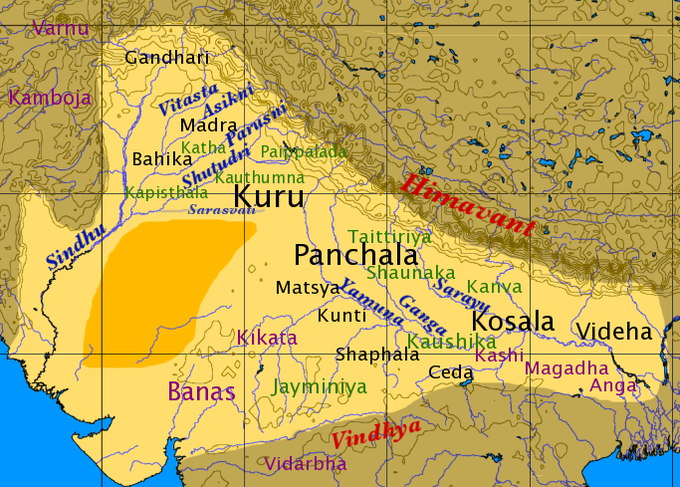
Map of northen India in the later Vedic Period: The Vedic civilization is thought to have been centered in the northern and northwestern parts of the Indian subcontinent. Here, the river Indus is shown by its Sanskrit name Sindhu. The location of Vedic shakhas is labelled in green, and the Thar desert is in orange.
By the 6th century BCE, various political units consolidated into large kingdoms called Mahajanapadas. The process of urbanization began in these kingdoms, and commerce and travel—even over regions separated by large distances—became easy.
Sanskrit Literature
The end of Vedic India is marked by linguistic, cultural, and political changes. The grammar of Pāini marks a final apex in the codification of Sutra texts and, at the same time, the beginning of Classical Sanskrit. The invasion of Darius I of the Indus valley in the early 6th century BCE marks the beginning of outside influence that continued in the kingdoms of the Indo–Greeks. After the end of the Vedic period, the Mahajanapadas period in turn gave way to the Maurya Empire (from c. 320 BCE), which is considered to be the golden age of classical Sanskrit literature.
Crafts in the Vedic Period
Crafts within Vedic culture include that of chariot-making, cart-making, carpentry, metal-working (creating instruments such as razors, bangles, and axes), tanning, bow-making, sewing, weaving, and making mats from grass and reeds. Many of these might have required full-time specialists.
The use of iron implements (krishna-ayas or shyama-ayas, literally meaning black metal or dark metal) increased in the later Vedic age, as did new crafts and occupations such as leather work, pottery, astrology, jewelry, dying, and vintnery. Apart from copper, bronze , and gold, later Vedic texts also mention tin, lead, and silver.
The black- and red-ware culture (BRW) is an early, Iron Age culture associated with the post-Rigvedic Vedic civilization that dates roughly from the 12th to 9th centuries BCE. It was succeeded by the painted grey-ware culture (PGW), an Iron Age culture that corresponds to the later Vedic period and that lasted from roughly 1200 BCE to 600 BCE.

Goblet from Navdatoli, Malwa: An example of pottery work from the black- and red-ware culture (BRW), an early, Iron Age culture associated with the post-Rigvedic Vedic civilization.
Vedic Literature
The Vedas are a large body of texts that originated in the Vedic period. Composed in Vedic Sanskrit, the texts constitute the oldest layer of Sanskrit literature and the oldest scriptures of Hinduism.
The reconstruction of the history of Vedic India is based on text-internal details. Linguistically, the Vedic texts could be classified in five chronological strata:
- The Rigvedic text: The oldest of the Vedas, thought to have been composed roughly between 1700 and 1100 BCE .
- The Mantra language texts: This period includes both the mantra and prose language of the Atharvaveda (Paippalada and Shaunakiya), the Rigveda Khilani, the Samaveda Samhita, and the mantras of the Yajurveda. This is the time of the early Iron Age in northwestern India and corresponds to the black- and red-ware (BRW) culture.
- The Samhita prose texts: This period includes the Brahmana part (commentary on mantras and ritual) of the Black Yajurveda and corresponds with the painted grey-ware (PGW) culture from c. 900 BCE.
- The Brahmana prose texts: The Brahmanas proper of the four Vedas belong to this period, as well as the Aranyakas, the oldest of the Upanishads, and the oldest Shrautasutras.
- The Sutra language texts: This is the last stratum of Vedic Sanskrit leading up to c. 500 BCE, and is comprised of the bulk of the Śrauta and Grhya Sutras, as well as some Upanishads.
The Upanishads are a collection of philosophical texts that form the theoretical basis for the Hindu religion. The Sanskrit term upanishad means sitting down near, implying sitting near a teacher to receive instruction.
Also known as Vedanta, they are considered by orthodox Hindus to contain the revealed truths (Sruti) concerning the nature of ultimate reality (brahman), and describe the character and form of human salvation (moksha).
All Upanishads are associated with one of the four Vedas—Rigveda, Samaveda, Yajurveda, and Atharvaveda—and have been passed down in oral tradition. More than 200 Upanishads are known, and with the Bhagavad Gita and the Brahmasutra, the Mukhya Upanishads provide a foundation for several later schools of Indian philosophy.

Rigveda in Sanskrit on paper: The Rigveda text is the oldest of the Vedas, thought to have been composed roughly between 1700 and 1100 BCE.
Maurya Dynasty
The Maurya Dynasty was an extensive empire that occupied all of northwestern India from 321–185 BCE.
Learning Objectives
Describe the Barabar Caves, the Pillars of Ashoka, and other examples of architecture and art of the Maurya dynasty
Key Takeaways
Key Points
- The Maurya Dynasty represents the first time in history that the Indian subcontinent was united under a single government.
- The most renowned emperor of the dynasty, Emperor Ashoka, is famous for propagating the Buddhist religion and preaching non-violence throughout India.
- Emperor Ashoka is responsible for the Pillars of Ashoka, as well as building more than 80,000 stupas .
- The Barabar Caves, the Mahabodhi Temple, and the Great Stupas at Sanchi are examples of the architecture from the Maurya period.
Key Terms
- dynasty: A series of rulers from one family.
- stupa: A dome-shaped Buddhist monument, used to house Buddhist relics.
Overview: The Maurya Dynasty
The Maurya Empire was a powerful Iron Age empire in ancient India ruled by the Maurya Dynasty from 321 to 185 BCE. Founded by Chandragupta Maurya, who overthrew the previous Nanda Dynasty, the empire had fully occupied Northwestern India by 320 BCE.
With an area of 5 million square kilometers and a population of 50 to 60 million, it was the first time in history that the subcontinent was united under a single government. The second emperor of the Maurya Dynasty was the son of Chandragupta, who expanded the empire further but never achieved the same level of notoriety as his own son, Ashoka.
By far the most famous emperor of the Maurya Dynasty, Ahsoka is considered one of the most famous rulers in all of Indian history as well as one of the great Buddhist kings. The decline of the Maurya Dynasty took place somewhat rapidly following the death of Ashoka. Historical theories for this include a succession of weak kings and the division of the Empire in two.
From Hinduism to Buddhism
After the Kalinga war (262–261 BCE), Ashoka converted from Hinduism to Buddhism. He preached non-violence and religious acceptance, and he laid a foundation for social harmony and religious transformation across all of India.
Ashoka also sponsored the propagation of the Buddhist religion into Sri Lanka, Southeast Asia, and Mediterranean Europe. The conversion of Emperor Ashoka to Buddhism legitimized and popularized the religion much like the conversion of Emperor Constantine to Christianity did.
The Pillars of Ashoka
He is famous for ordering that his edicts be carved into stones and caves around the empire and, later, for ordering that his edicts be carved into large sandstone pillars topped with statues of lions, known as the Pillars of Ashoka. These pillars, often exquisitely decorated, are the most widespread example of Mauryan architecture that exists today, with more than 40 spread throughout the Indian subcontinent. The works from this empire represent the earliest surviving remnants of monumental sculpture .
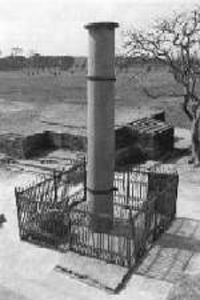
Pillar of Ashoka at Lumbini: The most widespread example of Mauryan architecture that exists today are the Pillars of Ashoka, which are often exquisitely decorated. There are more than 40 pillars spread throughout the Indian subcontinent.
The Barabar Caves and Other Temples
The Barabar Caves are the earliest example of Buddhist rock-cut architecture and were built during the Mauryan period. Attributed to Emperor Ashoka, the caves consist of temples, stupas, and monasteries that are carved elaborately out of granite. The decorated facade of the Lomas Rishi grotto, an offering to the Buddhist sect of the Ajivikas, is a good example of the high degree of craftsmanship.
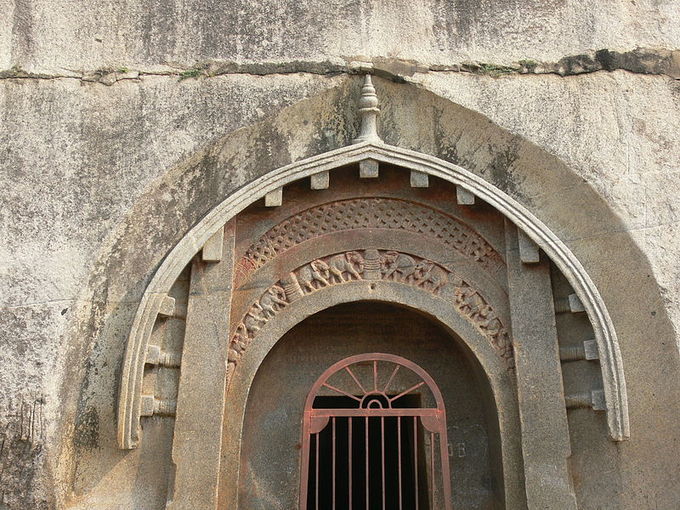
Barabar Caves: Built in the third century BCE during the Mauryan period, these are the oldest examples of Buddhist rock-cut architecture.
In addition, Ashoka was responsible for erecting several thousand Buddhist temples and stupas across India, such as the Mahabodhi temple. Another famous example includes the Great Stupas at Sanchi, whose gates are lavishly decorated with lions, elephants, figures of fertility, and images from the Jakata tales. Ashoka’s patronage of the Buddhist religion greatly influenced the visual iconography of time.
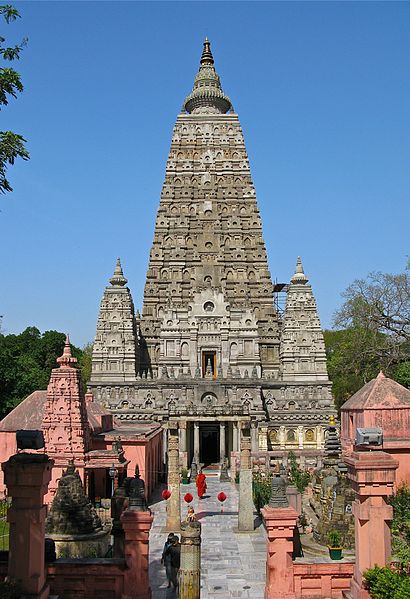
Mahabodhi Temple: The Mahabodhi Temple is one of the many temples erected by Ashoka across India.
- Curation and Revision. Provided by: Boundless.com. License: CC BY-SA: Attribution-ShareAlike
- Civiltu00e0ValleIndoMappa. Provided by: Wikipedia. Located at: http://en.Wikipedia.org/wiki/File:Civilt%C3%A0ValleIndoMappa.png. License: CC BY-SA: Attribution-ShareAlike
- Dancing Girl of Mohenjo-daro. Provided by: Wikipedia. Located at: en.Wikipedia.org/wiki/File:Dancing_Girl_of_Mohenjo-daro.jpg. License: CC BY-SA: Attribution-ShareAlike
- Shiva Pashupati. Provided by: Wikipedia. Located at: en.Wikipedia.org/wiki/File:Shiva_Pashupati.jpg. License: Public Domain: No Known Copyright
- Saylor.org's Ancient Civilizations of the World/New Civilization in the Indus Valley: Harappa. Provided by: Wikibooks. Located at: en.wikibooks.org/wiki/Saylor.org's_Ancient_Civilizations_of_the_World/New_Civilization_in_the_Indus_Valley:_Harappa. License: CC BY-SA: Attribution-ShareAlike
- Category:Indus Valley Civilization. Provided by: Wikimedia. Located at: commons.wikimedia.org/wiki/Category:Indus_Valley_Civilization. License: CC BY-SA: Attribution-ShareAlike
- Ancient History/Indian subcontinent/Indus Valley Civilization. Provided by: Wikibooks. Located at: en.wikibooks.org/wiki/Ancient_History/Indian_subcontinent/Indus_Valley_Civilization. License: CC BY-SA: Attribution-ShareAlike
- Indus Valley Civilization. Provided by: Wikipedia. Located at: en.Wikipedia.org/wiki/Indus_Valley_Civilization. License: CC BY-SA: Attribution-ShareAlike
- Saylor.org's Ancient Civilizations of the World/The Indus River Valley. Provided by: Wikibooks. Located at: en.wikibooks.org/wiki/Saylor.org's_Ancient_Civilizations_of_the_World/The_Indus_River_Valley. License: CC BY-SA: Attribution-ShareAlike
- Boundless. Provided by: Boundless Learning. Located at: www.boundless.com//art-history/definition/lapis-lazuli. License: CC BY-SA: Attribution-ShareAlike
- Boundless. Provided by: Boundless Learning. Located at: www.boundless.com//art-history/definition/steatite. License: CC BY-SA: Attribution-ShareAlike
- Bronze Age. Provided by: Wiktionary. Located at: en.wiktionary.org/wiki/Bronze_Age. License: CC BY-SA: Attribution-ShareAlike
- Rigveda MS2097. Provided by: Wikipedia. Located at: en.Wikipedia.org/wiki/File:Rigveda_MS2097.jpg. License: Public Domain: No Known Copyright
- Map of Vedic India. Provided by: Wikipedia. Located at: en.Wikipedia.org/wiki/File:Map_of_Vedic_India.png. License: Public Domain: No Known Copyright
- NavdatoliGoblet1300BCE. Provided by: Wikipedia. Located at: en.Wikipedia.org/wiki/File:NavdatoliGoblet1300BCE.jpg. License: Public Domain: No Known Copyright
- Painted Grey Ware. Provided by: Wikipedia. Located at: en.Wikipedia.org/wiki/Painted_Grey_Ware. License: CC BY-SA: Attribution-ShareAlike
- Black and Red Ware. Provided by: Wikipedia. Located at: en.Wikipedia.org/wiki/Black_and_Red_Ware. License: CC BY-SA: Attribution-ShareAlike
- Vedic period. Provided by: Wikipedia. Located at: en.Wikipedia.org/wiki/Vedic_period. License: CC BY-SA: Attribution-ShareAlike
- Upanishad. Provided by: Wikipedia. Located at: en.Wikipedia.org/wiki/Upanishad. License: CC BY-SA: Attribution-ShareAlike
- Vedic period. Provided by: Wikipedia. Located at: en.Wikipedia.org/wiki/Vedic_period. License: CC BY-SA: Attribution-ShareAlike
- Upanishad. Provided by: Wiktionary. Located at: en.wiktionary.org/wiki/Upanishad. License: CC BY-SA: Attribution-ShareAlike
- Vedic Period. Provided by: Wikipedia. Located at: en.Wikipedia.org/wiki/Vedic%20Period. License: CC BY-SA: Attribution-ShareAlike
- Sanskrit. Provided by: Wiktionary. Located at: en.wiktionary.org/wiki/Sanskrit. License: CC BY-SA: Attribution-ShareAlike
- CotthapAduc. Provided by: Wikipedia. Located at: en.Wikipedia.org/wiki/File:CotthapAduc.gif. License: Public Domain: No Known Copyright
- Barabar Caves 2. Provided by: Wikimedia. Located at: commons.wikimedia.org/wiki/File:Barabar_Caves_2.JPG. License: CC BY-SA: Attribution-ShareAlike
- Mahabodhi Temple Bodh Gaya Bihar India. Provided by: Wikimedia. Located at: commons.wikimedia.org/wiki/File:Mahabodhi_Temple_Bodh_Gaya_Bihar_India.jpg. License: CC BY-SA: Attribution-ShareAlike
- Maurya Empire. Provided by: Wikipedia. Located at: en.Wikipedia.org/wiki/Maurya_Empire. License: CC BY-SA: Attribution-ShareAlike
- Ashoka. Provided by: Wikipedia. Located at: en.Wikipedia.org/wiki/Ashoka. License: CC BY-SA: Attribution-ShareAlike
- Mahabodhi Temple. Provided by: Wikipedia. Located at: en.Wikipedia.org/wiki/Mahabodhi_Temple. License: CC BY-SA: Attribution-ShareAlike
- Sanchi. Provided by: Wikipedia. Located at: en.Wikipedia.org/wiki/Sanchi. License: CC BY-SA: Attribution-ShareAlike
- stupa. Provided by: Wiktionary. Located at: en.wiktionary.org/wiki/stupa. License: CC BY-SA: Attribution-ShareAlike
- dynasty. Provided by: Wiktionary. Located at: en.wiktionary.org/wiki/dynasty. License: CC BY-SA: Attribution-ShareAlike

